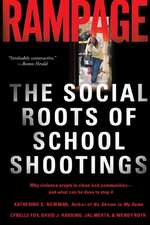Counter-hegemonic Resistance in China's Hong Kong: Visualizing Protest in the City
Autor Daniel Garretten Limba Engleză Hardback – 21 noi 2014
| Toate formatele și edițiile | Preț | Express |
|---|---|---|
| Paperback (1) | 394.51 lei 6-8 săpt. | |
| Springer Nature Singapore – 27 sep 2016 | 394.51 lei 6-8 săpt. | |
| Hardback (1) | 402.00 lei 6-8 săpt. | |
| Springer Nature Singapore – 21 noi 2014 | 402.00 lei 6-8 săpt. |
Preț: 402.00 lei
Nou
Puncte Express: 603
Preț estimativ în valută:
76.93€ • 80.68$ • 64.04£
76.93€ • 80.68$ • 64.04£
Carte tipărită la comandă
Livrare economică 01-15 aprilie
Preluare comenzi: 021 569.72.76
Specificații
ISBN-13: 9789812872357
ISBN-10: 9812872353
Pagini: 299
Ilustrații: IX, 396 p. 530 illus.
Dimensiuni: 155 x 235 x 27 mm
Greutate: 0.74 kg
Ediția:2015
Editura: Springer Nature Singapore
Colecția Springer
Locul publicării:Singapore, Singapore
ISBN-10: 9812872353
Pagini: 299
Ilustrații: IX, 396 p. 530 illus.
Dimensiuni: 155 x 235 x 27 mm
Greutate: 0.74 kg
Ediția:2015
Editura: Springer Nature Singapore
Colecția Springer
Locul publicării:Singapore, Singapore
Public țintă
ResearchCuprins
Preface.- Chapter 1: Introduction.- 1.1: A Rising Counter-hegemonic Chorus.- 1.2: Targets of Outrage.- 1.3: Protest as Cultural Object and Symbol of ‘One Country, Two Systems’.- 1.4: Why a subaltern-hegemonic construct?.- 1.5: Observational Framework: Visualizing Protest.- 1.6: Data & Method.- 1.7: Photo Essays.- 1.7.1: March on China’s Liaison Office over Suspicious Death of Tiananmen activist Li Wangyang, June 2012.- 1.7.2: Demonstration over Anti-Islam “Innocence of Islam” YouTube Video, September 2012.- 1.7.3: Protest over U.S. Intervention in Syria, September 2013.- 1.7.4: ‘Defend Snowden’ Rally from Charter Garden to the U.S. Consulate, June 2013.- 1.7.5: ‘Justice for Erwiana’ protests and ‘One Billion Rising for Justice,’ January and February 2014.- 1.7.6: Taiwan Sunflower Movement, Candlelight Vigil, and “We Save Taiwan in Hong Kong,” March 2014.- 1.7.7: ‘Anti-locust’ and ‘Patriotic Parody’ protests; ‘Toddler-gate’ Stickers, February and March 2014.- 1.7.8: ‘Save Vietnam’: South China Seas Conflict, June 2014.- 1.7.9: ‘Defend Hong Kong Press Freedoms!,’ March 2014.- References.- Chapter 2: Visual Struggle.- 2.1: Visual Struggle: Image Bites, Events & Politics.- 2.2: Targets of Visual Struggle.- 2.3: Spreading Conflagrations of Counter-Visuality.- 2.4: Photo Essays.- 2.4.1: Anti-Moral and National Education Movement (MNE) and Occupation of HKSAR Government Headquarters, September 2012.- 2.4.2: Dockworkers’ Occupation of Cheung Kong Centre in Central Business District, April 2013.- 2.4.3: Hong Kong Television (HKTV) ‘Core Values’ Protest & Occupation of the HKSAR Government Headquarters, October 2013.- 2.4.4: Anti-‘White Elephant’ Northeastern New Territories Development Plan Protest, May 2014.- 2.4.5: ‘Defend Teacher Lam!’ aka ‘WTF’ Protest in Mongkok Pedestrian Area, August 2013.- 2.4.6: ‘Yue Yuen Shoe Factory Workers Strike,’ May 2014.- 2.4.7: Alternative June 4thObservance at Tsimshatsui Clock Tower, June 2014.- References.- Chapter 3: The City as Enabler.- 3.1: The City.- 3.2: Public transportation.- 3.3: Urban fabric and textures as visualization.- 3.3.1: Street banners.- 3.3.2: Banner defacements.- 3.3.3: ‘Banner wars’.- 3.4: ‘Street clashes and serenades’.- 3.5: Photo Essays.- 3.5.1: ‘Falun Gong Banner Wars,’ December 2012 to April 2013.- 3.5.2: ‘Great George Street Wars,’ March 2014.- References.- Chapter 4: Venues of Counter-hegemonic Visuality; Days of Contention.- 4.1: ‘City of Protests’.- 4.2: Causeway Bay.- 4.2.1: Patterson Street Pedestrian Zone.- 4.2.2: Times Square.- 4.2.3: Victoria Park.- 4.2.3.1: June 4th.- 4.2.3.2: July 1st.- 4.2.3.3: Other events in Victoria Park.- 4.3: Wan Chai.- 4.4: Central and Western.- 4.4.1: Charter Garden.- 4.4.2.1: Occupy Central (Occupy Wall Street-type).- 4.4.3: Statue Square.- 4.5: “Days of Contention” Photo Essays.- 4.5.1: ‘Hong Kong Revolutions 2013’ New Year’s Day Procession, January 2013.- 4.5.2: ‘May Day’ Procession from Victoria Park to HKSAR Government Headquarters, May 2012.- 4.5.3: June 4th Candlelight Vigil in Victoria Park, June 2012.- 4.5.4: June 4th Candlelight Vigil in Victoria Park, June 2013.- 4.5.5: July 1st procession, July 2012.- 4.5.6: July 1st procession, July 2013.- 4.5.7: ‘Unlawful Assembly’ Procession for Chinese Dissidents on China’s National Day, October 2013.- References.- Chapter 5: Cityscape as Oppressor.- 5.1: Urban maneuvers.- 5.1.1: 'Political flowerbeds'.- 5.1.2: Flowers, but no 'Jasmine'.- 5.2: Police Surveillance.- 5.3: Designated Public Activity Areas, Press and Security Zones.- 5.4: Photo Essay.- 5.4.1: From ‘City of Protests’ to ‘City of Barriers’.- References.- Chapter 6: Discussion.- 6.1: What can be seen.- 6.2: ‘Streets of Fire’.- 6.3: “Take it to the street”.- 6.3.1: Guy Fawkes & ‘V for Vendetta’.- 6.3.2: “Who's Afraid of Ai Weiwei?”.- 6.4: “Attack of the Visual”.-6.5: “Fortress Hong Kong”.- 6.6.1: ‘Hong Kong’s Tank Man,’ June 2014.- 6.6.2: ‘Fortress Hong Kong’, ‘No White Paper!’, and ‘OCLP Dry-Run,’ June and July 2014.- References.- Chapter 7: Conclusion.- 7.1: Conclusion.
Notă biografică
Dan is a PhD student at City University of Hong Kong in the Department of Applied Social Sciences. His thesis focuses on Hong Kong-China relations under the 'One Country, Two Systems' policy and the consequences of hegemonic and counter-hegemonic moral panics over sovereignty, patriotism, and national identity in post-Handover Hong Kong. He has lived and worked in Asia and in the United States working in the Information Communication and Technology (ICT), information security, and national security fields for nearly three decades. His graduate work involved the convergence of visual and verbal communications and undergraduate emphasis was in U.S. diplomatic history in East Asia and Japanese history. He has presented papers on China and Hong Kong topics and U.S.-Sino relations at conferences in Asia, Europe, South America, and North America. Dan's publications in 2013 and 2014 cover issues such as anti-communist sentiment in Hong Kong; the use of the People's Liberation Army as a Chinese soft power resource; subaltern political iconography resisting hegemony in competitive authoritarian political systems; online visual resistance; and, the visualization of counter-hegemonic moral panics. His published scholarly work presents a visual investigation of increasing tensions between Hong Kong and mainland China over cultural, social, and political integration.
Textul de pe ultima copertă
This book and associated collection of visual data and sociological observations examine how the Hong Kong Special Administrative Region (SAR) has been visually re-imagined, transformed, and utilized by its subalterns in the post-Handover period to reproduce their aspirations and demands for greater democracy and social justice while simultaneously contesting the hegemonic pressure exerted by China under the “One Country, Two Systems” ideology. It provides a rich visual description and narrative of how Hong Kong’s many repressed social and political actors have struggled to make their voices heard under its competitive authoritarian political system. The book addresses the growing scholarly interest in the visual analysis of global protests and social movements as salient sources of sociological data and on the creation of meaning. By innovatively tackling the visual culture and visuality of subaltern resistance in Hong Kong it contributes to our understanding of contentious SAR-China politics and the New Social Movement, and will be of great interest to Hong Kong, resistance, social movement, and visual studies scholars.
Caracteristici
Provides a compelling visual narrative of Hong Kong China's 'City of Protest' Vividly captures the “Hongkonger uprising” under Chinese rule Investigates contentious visual politics and performances under ‘One Country, Two Systems’ Elucidates image politics in a Chinese competitive authoritarian political system Visualizes street-level counter-hegemonic cultural, political and social resistance Includes supplementary material: sn.pub/extras











